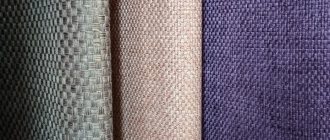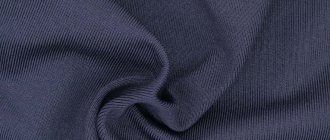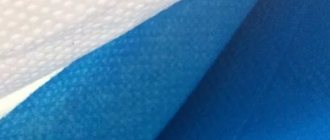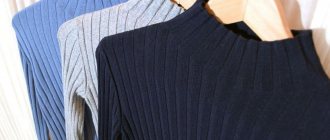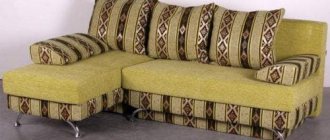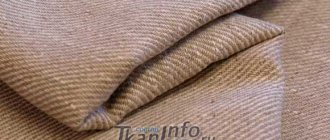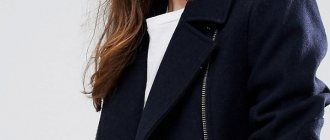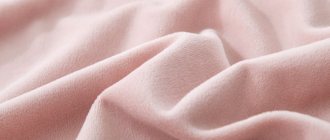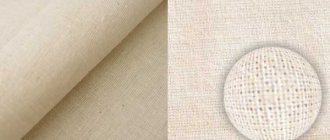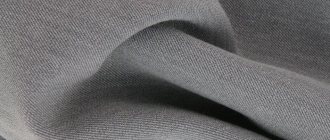What kind of fabric
Rep fabric is a dense, ribbed material made primarily from natural raw materials. What does the word rep mean? It comes from the German rippe, which means tripe.
The material was especially popular in the 18th century. They used it to cover walls in residential buildings and reupholster furniture. Women's dresses and men's suits were made from thinner fabrics.
The rep or rib in the fabric is obtained through a special weave. Its peculiarity is that the threads of one system completely overlap the fibers of the other.
In the catalogs you can find a description of rep fabric: dense, rigid material with a small horizontal or vertical rib. Despite the rigidity, the material is pleasant to the touch and comfortable to wear.
What kind of material is this?
To obtain a ribbed fabric, the weave is made in such a way that the warp thread intertwines more than two weft threads.
Such reps, which have longitudinal scars, are called basic (emphasis on the second syllable). Another weaving method is used, in which the weft thread is strengthened. In this case, the scars will have a transverse direction, and the material is called weft. Both fabrics have an interesting texture and great strength. They are produced plain (or bleached) and printed. Until the century before last, reps were made only from twisted silk threads, while the thinner fabric that was used to make clothes was called “rips” (as opposed to furniture) . Subsequently, this material began to be made from cotton and wool. Cheaper fabric gradually became more common, and by the beginning of the 20th century, ribbed silk textiles had become a rarity. The last surge in fashion for this material occurred in the middle of the last century, when women began to wear trousers, as well as tight-fitting dresses and voluminous skirts. Since then, reps have not become a leading brand, although it continues to be in demand to this day.
Compound
In the 18th century, rep fabric consisted only of silk fibers. The material was very expensive. By the 19th century, it began to be made from cotton and wool, which made the fabric more affordable.
Modern reps are still made from cotton, wool, silk, both 100% and with the addition of synthetic threads. The mixed material is more wear-resistant.
On sale there are fabrics with a composition of cotton, silk and polyester. The percentage of synthetic threads in them is no more than 30%.
The pattern (thin rib) on the surface of the fabric creates a rep weave. There are two types of it - weft and main.
With weft weaving, a transverse scar is formed on the surface of the rep. This occurs due to the weft threads overlapping the warp threads. Only the weft yarn is visible on both the front and back sides. The more threads are overlapped, the wider the hem. The minimum number of “covered” fibers is two.
The threads that form the surface of the material are thinner, more elastic, and located close to each other. Fibers that overlap thicker ones are sparsely located.
Types of reps
Almost until the 19th century, rep material was made only from silk threads that were twisted. At the same time, the fabric, which was thinner and used for sewing clothes, was called “rips,” and “reps” meant furniture fabric. Later, the material began to be made from cotton and wool fibers. These species became more and more popular among the common people, and silk reps became rare.
Rep kanzashi
The last time it was fashionable was in the mid-20th century, when skirts, trousers and dresses were made from it. Since then, the fabric has become less popular in fashion, but is still used for many purposes.
Knitting reps on a silver knitting machine
As already mentioned, there are two classifications of reps:
- weft, when the rib is shaped transversely;
- the main one, when the scar is shaped longitudinally.
You might be interested in this. Features of interlock: what are such fabrics made of?
Despite the difference in sewing technology, both of these types are equally elastic and durable. However, there are also differences in that the transverse rib visually stretches the silhouette of the figure and reduces its volume.
According to its composition, reps are divided into:
- satin reps, which is made from polyester and cotton. It is used for sewing curtains and curtains;
- Lurex rep with the addition of “metallic” threads. Ribbons for decoration are made from it;
- cotton lurex is the most common, as it is pleasant to the body and perfectly breathable;
- velor rep is a new type of material woven from synthetic fibers. The composition may also include cotton and wool.
Blue grosgrain ribbon 15 mm
Types and their properties
Depending on the weave, rep fabric is divided into two types:
- weft (transverse rib);
- main (longitudinal scar).
They are similar in their characteristics, equally durable and elastic. But products with a transverse rib stretch the silhouette and visually reduce the volume.
The composition is:
- One of the varieties of satin rep . It is made from polyester, and cotton can also be added to the composition. The material is elastic, wear-resistant and is used to make curtains or curtains.
- There is also decorative fabric - rep with lurex . It is used to make ribbons that are used for finishing.
- Cotton rep is the most common type of fabric. It is pleasant to the body, allows air to pass through well, and removes excess moisture in hot weather.
- A relatively new variety of rep velor . It is woven from synthetic fibers. Both cotton and wool threads can be added to the composition. The material looks like velvet.
The material lends itself well to coloring and does not fade. Most often the rep is monochromatic; fabric with a pattern is rarely produced. Reps are dyed in different colors: red, blue, black, cream, black.
Basic properties
Features of the technology for obtaining rep fabric determined the following characteristics of this textile:
- high density, strength and wear resistance;
- hygroscopicity and “breathing” properties;
- resistance to deformation;
- low creasing and easy to wash.
Natural rep fabric is very comfortable to wear and at the same time practical. It is important that it does not stretch and is well suited for tight-fitting styles . In addition, the longitudinal scars of the duck rap well stretch the silhouette and give a slim figure. At the same time, the density of this material allows you to create three-dimensional structures and stable folds.
Application area
Reps is a suiting fabric used to make both men's and women's suits. The material holds its shape well, so it is often used in sewing classic jackets or jackets.
A rep dress is suitable for the office, especially a sheath or A-line silhouette. Ribbed silk fabric is suitable for evening or cocktail dresses.
Women's clothing made from reps is not limited to dresses and formal suits; blouses and skirts are also made from this fabric. Thick woolen material is used for demi-season outerwear.
The material has also found application in sewing children's clothing. Loose-fitting trousers with many pockets for boys are made from reps. It is also used for sewing lightweight children's windbreakers.
Hats, caps, caps are sewn from cotton rep, and it is used to make elastic belts. Increasingly, dense and textured material is used to sew bags in grunge and boho styles. It is used in the shoe industry for finishing or making shoes (slip-ons, sneakers).
Rep ribbon is used to make accessories. It is used to decorate hats, bags, and brooches. Hair bows, headbands, and hairpins are made from grosgrain ribbon. Gradient rep tapes give freedom for creativity. They can be monochrome or color.
The fabric has also found its application in home textiles. Bedspreads, curtains, and roller blinds are made from reps. The material is suitable for room decoration. They use it to cover walls, make complex draperies and curtains.
The fabric is used by costume designers and theater decorators. With its help, it is possible to recreate the interiors of the 18th – 19th centuries. It is also suitable for sewing historical costumes. Reenactors use the material to recreate clothing from different eras.
Rep corduroy is most often used for furniture upholstery. Thanks to the polyester composition, it retains its attractiveness for a long time and does not wear out.
What to sew from reps?
Currently, mainly cotton and blended fabrics with ribbed weave are on sale. They are used for sewing men's and women's trousers, summer suits, dresses, practical children's clothing, as well as in the production of shoes. As many years ago, grosgrain ribbons are used to decorate hats and other accessories.
A new direction for textiles in this group is fabric such as rep velor. It is made mainly from synthetic or mixed raw materials. This fabric combines a ribbed texture and velor pile, as a result of which it has great strength, elasticity, and a very beautiful pile surface of various colors. The main application of this combined material is furniture upholstery.
The use of these materials for historical and theatrical costumes remains traditional, since this fabric, like no other, allows you to create rigid three-dimensional structures characteristic of the fashion of past centuries. And finally, classic rap continues to be in demand as a decorative fabric, especially in official and retro-style interiors. It is used for upholstering furniture, walls, creating curtains and draperies - this is exactly how the interiors of the Russian Foreign Ministry are decorated.
Composition and properties of reps
In the 18th century, reps were made from silk; in the 19th century, wool and cotton became additional materials. Modern products include:
- cotton;
- wool;
- silk.
Synthetic threads are added to each material to increase the wear resistance of reps, for example, polyester. The synthetic content usually does not exceed 30%.
The properties of reps include:
- Tisi fabric: material features, areas of application, care recommendations
- Good paintability.
- No shedding.
- A rigid structure with characteristic longitudinal lines that make the figure more slender by hiding its flaws.
- Inability to retain moisture in its structure.
Reps in different shades
More often reps are painted in one tone: products with patterns are rare, although prints can be applied to the surface.
